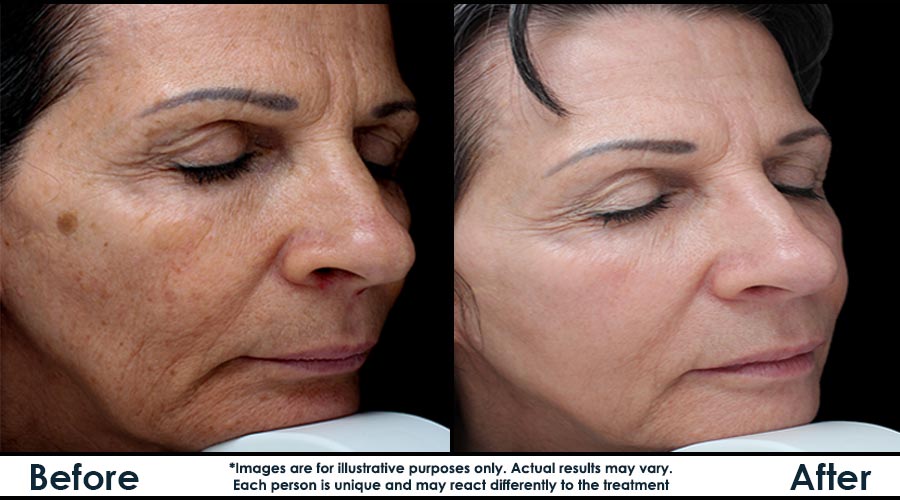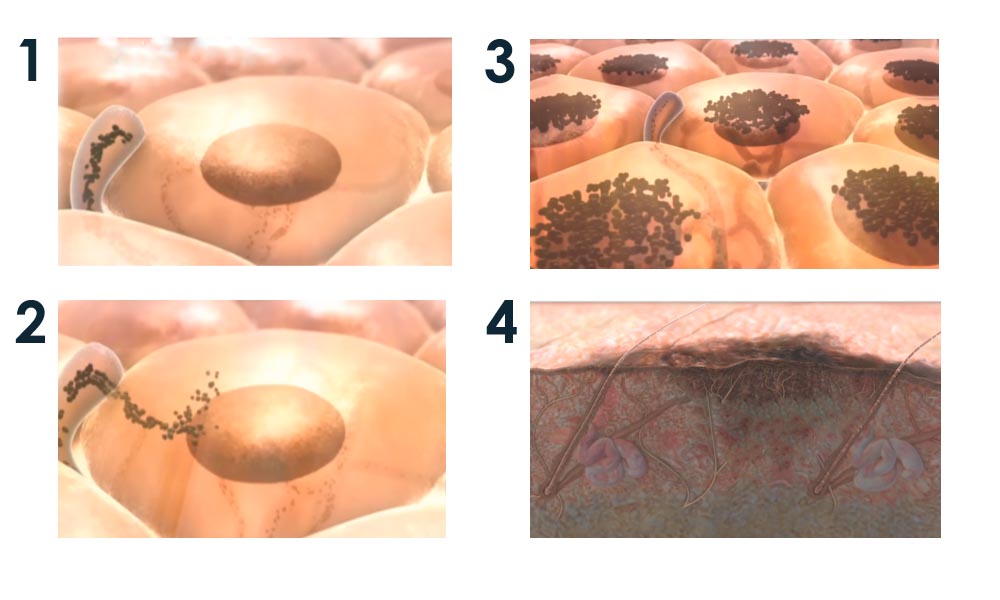Hyperpigmentation
It can be caused by sun damage, inflammation, or other skin injuries. We can help you reduce it.
Post-Treatment Results for Pigmented Spots

Our Approach to Treating Pigment Spots
1
Consultation and facial analysis using 3D photos.
2
Proposal of a treatment plan adapted to the types of pigment spots.
3
Beginning of treatments with follow-ups made during and at the end of them to ensure their effectiveness.
What Is a Pigment Spot?
What is a pigment spot?
Pigment spots are a result of the hyperproduction of melanin in a given region of the face or body. Melanin is made up of dark organic pigments. Four colors are possible: black, brown, red or yellow. It is the concentration and the mixture of these colored pigments which give the color of hair, skin and eyes. Its role is to protect us from ultraviolet radiation which destroys the DNA of cells. The darker the melanin, the darker the skin and the better its protection from the sun.
The cells responsible for producing melanin are called melanocytes. Each person has the same number regardless of their skin complexion. So why are there darker and lighter skin types? The explanation is quite simple. Melanocytes are, in a way, small ink taps that can open or close. When they are open, the production of melanin activates within the deep layers of the epidermis and gradually rises to the surface. The longer the taps remain open, the darker the skin. In pale skin, the taps open more when exposed to the sun. When the latter decreases, the small taps close.
From this information, we can now deduce that pigment spots appear when these melanocytes are out of balance or are always in high demand due to prolonged sun exposure. The pigment spots then remain very visible. In general, these spots begin to appear around the age of 30. People with fair skin are most likely to be affected since their melanocytes will tend to be more excited by the sun. In the case of dark skin, these spots are especially likely to appear during the formation of scars, such as after a pimple. The melanocytes are then activated by inflammation, leaving a dark mark on the skin. During pregnancy or while taking hormones, a disruption of melanocytes can also occur and facilitate the appearance of a dark mask.
Types of pigment spots:
- Pigment spot caused by a scar, such as a pimple;
- Hormonal hyperpigmentation;
- Pregnancy mask;
- Age spot that appears after quarantine;
- Solar Lentigo or Sunspot.
Formation of Pigment Spots on the Skin

Possible causes of the appearance of pigment spots
- Scars from an injury or pimple.
- Hormonal fluctuations in women related to their menstrual cycle.
- Certain medications or hormones.
- Inflammation of the follicles after shaving.
- Pregnancy.
- Sun exposure.
- Genetic, hereditary or other factors.
- Disruption of melanocytes as they age.
Our Approach
We use a scientific approach to determine the appropriate treatment needed. First, we determine the depth and origin of the pigment spots on your skin. Even though many are caused by sun exposure, they can have completely different origins (as mentioned earlier). Our 3D camera allows us to see what is happening within the different layers of the skin and the intensity of the spots to be treated. It is necessary to adapt the treatment plan according to what is discovered during the analysis of the 3D photos.
It is important to understand that it is not enough to just treat stains with one and the same laser. If we take an example of sun exposure. This can activate the production of spots due to the burning and inflammation it creates in the skin. Using a laser on these spots, in particular, can be effective, ineffective or even detrimental if improperly used. Many people will have an immediate result and some will find that the spots come back over time or that some have worsened.
At Infinium, our approach is very gradual in order to precisely avoid this scenario. We recommend the use of medicated creams at home to slow down the production of pigments. The latter is very effective for deep spots. Lasers, pulsed lights and chemical peels can be used in combination to treat deep and superficial stains. In this case, the energy intensity used can be increased safely. This is how we achieve long-lasting results.
Concerning spots of hormonal causes, caution is advised. We have established effective treatment protocols for these.
At Infinium, several follow-ups are carried out throughout the process to ensure the success of the treatments.



